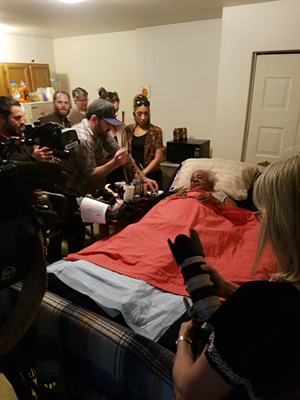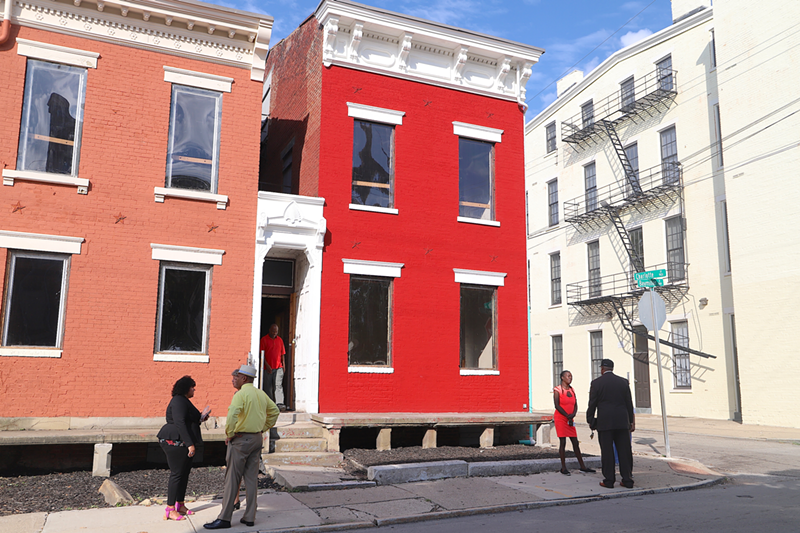By March 2021, the West End will have a $250 million professional soccer stadium operating in the heart of the neighborhood. That is likely to bring some big change — shifts that neighborhood groups and others are trying to help residents adjust to.
According to a study commissioned as part of a community benefits agreement around the coming stadium, roughly 44 percent of residents in the West End are vulnerable to displacement.
Seven Hills Neighborhood Houses, the longstanding nonprofit that serves as the West End's community development corporation, has worked with the Port of Greater Cincinnati and other groups to administer two programs it is hoped will help residents deal with rising rents, code compliance scrutiny and other potential side effects of the coming soccer stadium and general growing interest in the neighborhood's real estate.
Those efforts have already borne fruit for some West End residents — though others continue to struggle.
Meanwhile, longer-term planning is also underway. A housing study commissioned by Seven Hills and the Port and paid for by FC Cincinnati could shed more light on what is needed in terms of housing. That study, conducted by Atlanta-based APD Urban Planning and Management, is in its final stages and should be released in the next few weeks, according to the Port.
A few of the takeaways from that report APD discussed at an Aug. 21 presentation for residents underscore why Seven Hills and other advocates for the West End feel the situation is urgent.
According to the report, which uses Census data, a parcel-by-parcel survey of the neighborhood's housing stock and a separate qualitative data gathering effort by Design Impact, more than a quarter of the West End's 6,650 residents are "extremely threatened" by the prospect of displacement due to low or fixed incomes. Another 17 percent are threatened to some lesser degree.
According to surveys, 80 percent of residents in the neighborhood want to stay there.
Roughly 87 percent of the neighborhood's residents are renters, Census data reveals. Subsidized housing — either in the form of housing projects or landlords accepting housing choice vouchers — makes up about 1,700 units of the community's housing, making its residents somewhat less vulnerable to displacement than market-rate housing.
APD's study will also provide nine recommendations in its finished form.
Among them: which parts of the neighborhood could best handle new development. The study assessed vacant parcels in the West End and found four areas with lots of vacant land in which new development could occur with minimal direct displacement. If those developments included affordable housing, that could help existing residents struggling to find or keep homes in the neighborhood.
"We got a lot of information from Design Impact, we got existing conditions data, we used Census data," APD Chief Operations Officer Bridget Wiles says. "We took all that data and came up with actual areas where you could price-appropriate housing that would result in the least amount of displacement possible. We think that's going to be very valuable, and once we move into implementation, those things are going to be very important."
In the meantime, Seven Hills is working to mitigate immediate needs from residents. One initiative the nonprofit is overseeing involves $100,000 provided by FC Cincinnati to help West End homeowners with repairs to their buildings. So far, one resident has applied and successfully used $10,000 from the program (the individual limit) plus some other funding to shore up their house. Four other homeowners have been accepted into the program and 17 total have applied.
Another effort to address residents' current needs is an eviction prevention program funded by $176,000 from the relocation of Tri-State Wholesale Building Supplies. FC Cincinnati purchased the company's West End location, and it subsequently bought city-owned land in Lower Price Hill. The city's proceeds from that sale go toward eviction prevention in the West End.
So far, 32 West End residents have received eviction prevention aid totaling roughly $18,000, Seven Hills says. That money goes to helping residents avoid eviction proceedings by paying one month's delinquent rent plus late fees for residents who have fallen behind but can show that they will be able to pay future months' rent. Seven Hills is also working with a separate city-funded eviction prevention program run by Saint Vincent DePaul that can provide more help to tenants who are further behind in their payments.
Though the program has helped some residents, it can't help everyone. One severely cost-burdened (paying more than a third of income for rent) applicant to the program was evicted because she owed two months' rent plus late fees. The resident was paying $775 a month on a monthly income of $1,600.
"How could she continue paying that?" Seven Hills Neighborhood Houses Community Engagement Director Tia Brown asks. "We're hoping to help her find a more affordable place to live, but with the changes happening, that's getting harder and harder."

Others are struggling to find affordable housing in the neighborhood as well, including four remaining residents in two buildings purchased by FC Cincinnati earlier this year. Those residents, including 99-year-old Mary Frances Page, were informed by the buildings' former owner that they would need to move in February. Controversy ensued — the team had made promises that it wouldn't displace anyone — and the team and residents agreed to a private settlement that allowed the roughly dozen households to stay in their homes until Jan. 31 next year. According to sources close to the deal, it also involved affordable housing for the residents funded by the team.
FC Cincinnati recently included the land occupied by Page's apartment building in its planned development zoning request. That request will go before the Cincinnati Planning Commission on September 13. The commission will hold a staff hearing about the proposed change in the West End Aug .28. The team has purchased a number of parcels running up to Liberty Street, though its requested planned development zoning only runs up to Wade Street. The team has indicated it will use the parcels within the zoning application for surface parking in the near future, though it is believed the team wants to develop the larger area eventually.
Most residents have found other places to live, but the remaining four are having difficulty, Page's niece and caretaker Kim Dillard says. Dillard would like to have Page out of her building at 421 Wade Street before the weather gets cold but has run into problems finding suitable affordable housing, the application process for housing she has found and other issues. She says she has viewed an apartment in City West, a nearby housing development, but is afraid it won't be a great fit for Page due to security and accessibility concerns.
"It is just a whole bunch of roadblocks put in front of us," Dillard says, relating troubles with applications that request income verification and employment history for her elderly aunt. "It's not like we don't want to get out of these buildings."
Help with housing could be coming — albeit in pieces, and at a long-term pace. One development that could help West End residents and others across the region searching for affordable housing: the Cincinnati Metropolitan Housing Authority will open up its waitlist for housing choice vouchers, colloquially known as Section 8, from Sept. 9 to Sept. 12. It will be the first time since January 2017 that the waitlist has been open. Currently, there are 1428 people on the list waiting for housing vouchers.
Longer-term, Seven Hills, the Port and APD say the results of the finished housing study could guide future policy and development decisions in the West End. The study has identified gaps in housing availability — for families with incomes around $18,000 a year and for those above $56,000 a year. The neighborhood's median household income is roughly $14,000 a year, according to Census data, and 65 percent of its residents live in poverty.
The market could address the gap in higher-income housing as real estate continues to heat up in the West End, but the lower-income residents will likely need some policy intervention.
Even before talk of the stadium, interest in the West End was ramping up.
In 2012, there were 16 home improvement or mortgage loans written in the three full Census tracts that make up the West End, according to federal data. In a neighborhood that is 85 percent black with a median household income of about $15,000 a year, the $2,124,000 in loans went to applicants with a median income of $58,000 a year. Only three of the recipients were black.
By 2017, the last year for which federal data is available, there were 41 such loans worth $5,554,000 sold to applicants with a median income of $80,000 a year. Thirteen of the recipients of those loans — about 30 percent — were black.
Meanwhile, funding for new affordable housing projects in the West End has lagged. The neighborhood’s last allocation of Low Income Housing Tax Credits — which fund the development of much of America’s low-income, non-Section 8 housing — was $972,000 for the Sands Senior Apartments in 2014.
Seven Hills is working to raise money for the development of housing that will be affordable to residents of the neighborhood, hosting fundraisers and looking into other ways to finance housing.
"There is a lot of work that has already been done," Brown says. "There is a lot more to do. We're hoping we can do it all together so that when big development comes, we're not at its mercy."


